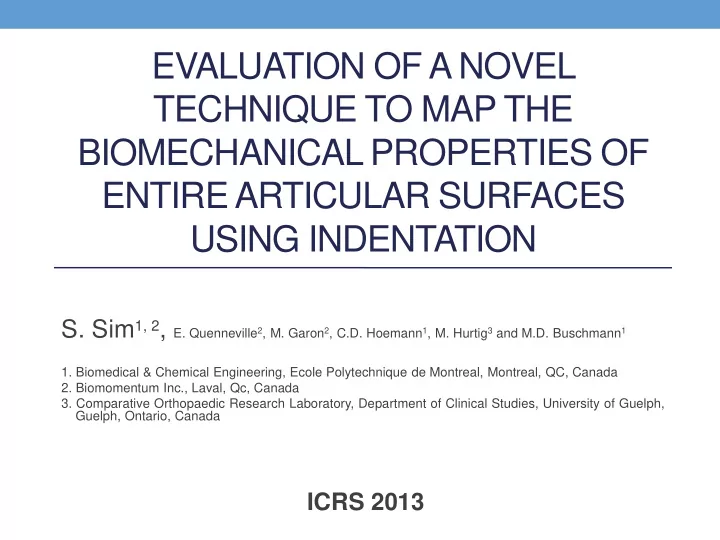

EVALUATION OF A NOVEL TECHNIQUE TO MAP THE BIOMECHANICAL PROPERTIES OF ENTIRE ARTICULAR SURFACES USING INDENTATION S. Sim 1, 2 , E. Quenneville 2 , M. Garon 2 , C.D. Hoemann 1 , M. Hurtig 3 and M.D. Buschmann 1 1. Biomedical & Chemical Engineering, Ecole Polytechnique de Montreal, Montreal, QC, Canada 2. Biomomentum Inc., Laval, Qc, Canada 3. Comparative Orthopaedic Research Laboratory, Department of Clinical Studies, University of Guelph, Guelph, Ontario, Canada ICRS 2013
Purpose • Mechanical testing of articular cartilage is a useful outcome measure in studies of cartilage degeneration and cartilage repair. • Mechanical testing can be done in different experimental configurations: Indentation Compression Bending Shear Tension Torsion
Practical Advantages Articular surface of Indentation Tide mark Calcified cartilage • Cartilage need not be harvested Subchondral bone Cancellous bone from the articular surface • Minimal disruption of the articular surface • Maintains the mechanical environment of the cartilage layer and its interaction with the subchondral bone • Testing multiple sites However Indentation requires the compression axis aligned perpendicular to the articular surface. Mathematical models are more complex in indentation with a spherical indenter. Picture from: http://www.kneeclinic.info/
Methods spherical indenter for a new automated indentation technique multiaxial load cell – uses Fx, Fy and Fz to calculate the normal force 3-axis mechanical tester – uses 3 displacement components to provide a perpendicular displacement based on the surface orientation • Automated Perpendicular Indentation: Contact coordinates (x,y,z) Normal Thickness Surface orientation of predefined positions and 4 force/displacement vs ( θ z ) is missing surrounding positions time
Methods spherical indenter for a new automated indentation technique multiaxial load cell – uses Fx, Fy and Fz to calculate the normal force 3-axis mechanical tester – uses 3 displacement components to provide a perpendicular displacement based on the surface orientation • Automated Perpendicular Indentation: Contact coordinates (x,y,z) Normal Thickness Surface orientation of predefined positions and 4 force/displacement vs ( θ z ) is missing surrounding positions time
Methods spherical indenter for a new automated indentation technique multiaxial load cell – uses Fx, Fy and Fz to calculate the normal force 3-axis mechanical tester – uses 3 displacement components to provide a perpendicular displacement based on the surface orientation • Automated Perpendicular Indentation: Contact coordinates (x,y,z) Normal Thickness Surface orientation of predefined positions and 4 force/displacement vs ( θ z ) is missing surrounding positions time
Methods spherical indenter for a new automated indentation technique multiaxial load cell – uses Fx, Fy and Fz to calculate the normal force 3-axis mechanical tester – uses 3 displacement components to provide a perpendicular displacement based on the surface orientation • Automated Perpendicular Indentation: Contact coordinates (x,y,z) Normal Thickness Surface orientation of predefined positions and 4 force/displacement vs ( θ z ) is missing surrounding positions time
Methods spherical indenter for a new automated indentation technique multiaxial load cell – uses Fx, Fy and Fz to calculate the normal force 3-axis mechanical tester – uses 3 displacement components to provide a perpendicular displacement based on the surface orientation • Automated Perpendicular Indentation: Contact coordinates (x,y,z) Normal Thickness Surface orientation of predefined positions and 4 force/displacement vs ( θ z ) is missing surrounding positions time
Methods • Thickness measurement: Vertical Thickness can Position of the Position of the force/displacement vs be obtained cartilage surface subchondral bone time Technique adapted from Jurvelin et al., 1995
Methods • Thickness measurement: Vertical Thickness can Position of the Position of the force/displacement vs be obtained cartilage surface subchondral bone time Technique adapted from Jurvelin et al., 1995
Analysis – Thickness Vertical Cartilage Distance surface Subchondral bone Surface orientation Thickness = vertical distance x cosine (surface orientation)
Analysis – Automated Indentation Normal Force (N) Elastic Model Using the known in Indentation Instantaneous Modulus thickness (Hayes, 1972) (MPa)
Methods Device Equipment Mach-1 v500css Intradermal Bever Camera Spherical from Needle from Point Grey indenter Biomomentum Inc. from Precision Glide Research Multiaxial mechanical Needle size of 26G 3/8” Radius of 0.5 mm FMVU USB 2.0 tester
Methods • Mechanically-Controlled Surface Mapping sample camera picture (1280x960 pixels) position grid superimposed converted in units of length (mm) MACH-1
Methods • Samples: Ovine Murine Small dimensions To reveal the high spatial resolution and sensitivity of this novel technique current use in articular use in many disease and cartilage repair studies developmental studies Male Male 100-140 lbs 0.08 lbs 4-5 y.o Mature No indications of joint pathology Visually normal tibial plateau and femoral condyles were collected from closed stifle joints Pictures from: http://www.123rf.com/
Results 3 ≈ 150 measurements/articular surface D S ≈ 1 minute per indentation U R F A ≈ 30 seconds per thickness C E
Discussion Works with any type of articular cartilage as thin as murine. Thickness obtained are in line with those reported in the literature (Stockwell et al., 1971; Frisbie et al., 2006). Results can also be fit with poroelastic models, e.g. the fibril-reinforced poroelastic model where the permeability, the matrix modulus and fibril modulus can be extracted. ≠
Discussion • Possible applications: • Characterization of articular surfaces in cartilage repair studies • Monitoring of cartilage degeneration • Monitoring of the mechanical properties in knockout mice knee joints • Characterization of bone, skin or different materials for implants Pictures from: http://www.genome.gov/
Conclusions • This novel indentation mapping technique allows to highlight the spatial variation over the entire surface. • A promising tool for studies that need to characterize mechanical properties of the articular surface.
Acknowledgement • Funding provided by National Sciences and Engineering Research Council (NSERC), the Fonds du recherche du Québec - Nature et technologies (FRQ-NT) and Biomomentum Inc.
Questions
Recommend
More recommend